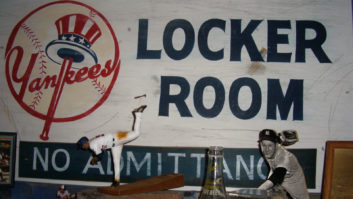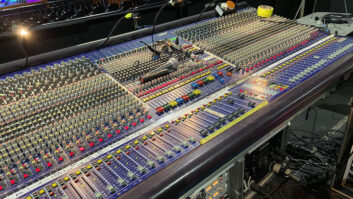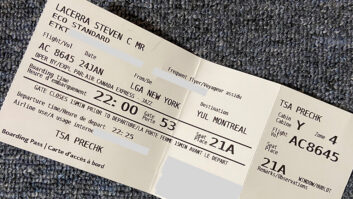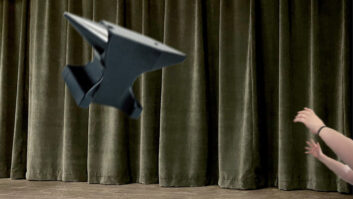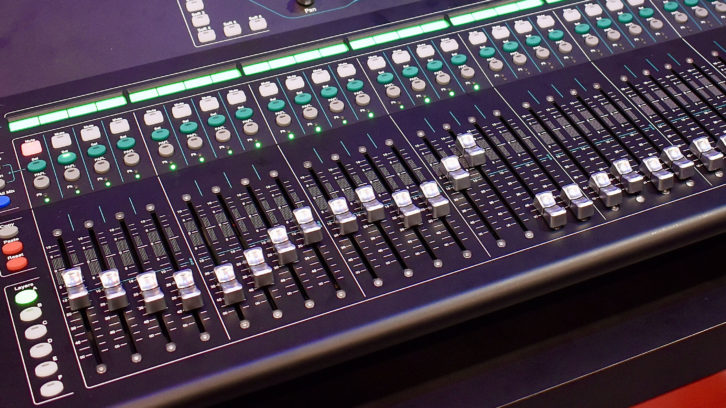 Someone recently asked me if there was a reason that input lists are created in the order that they typically appear, which made me start thinking about the “convention” regarding input lists: They almost always start with the drums and end with the vocal channels.
Someone recently asked me if there was a reason that input lists are created in the order that they typically appear, which made me start thinking about the “convention” regarding input lists: They almost always start with the drums and end with the vocal channels.
I was ready to explain that I’ve never really seen an artist’s input list that varied much from that methodology, but then I had a flashback to 1995, when I started subbing as Blue Öyster Cult’s front-of-house engineer. They were using an input list created by my predecessor, and it looked something like this:
Channel Instrument
1 Overhead right
2 Overhead left
3 Floor tom 2
4 Floor tom 1
5 Rack tom 2
6 Rack tom 1
7 High hat
8 Snare
9 Kick drum
10 Bass DI
11 Bass Mic
12 Piano
13 Organ
14 Synth
15 Allen Guitar
16 Eric Guitar
17 Don Gtr L
18 Don Gtr R
19 Eric Vocal
20 Don Vocal
21 Jon Vocal
22 Keyboard vocal
23 Crew mic (cowbell and bking vox)
There may have been a channel in there for “Don Gtr DI” or “Rack Tom 3,” but that was the basic idea. It’s 28 years and several hundred thousand miles ago, so my memory might be a little fuzzy. Ha!
It’s an odd arrangement, especially when compared to the way most people start their input list with the kick drum on channel 1, snare on channel 2, etc. As I recall, the inputs were arranged in this manner because the previous engineer felt that it was easier to access critical channels (kick, snare, hat) by placing them toward the center of the desk.
He had a point. At that time, we were all mixing on large-format analog consoles that were big and bulky, so placing the less-often used channels at the end of the desk had some merit. It also may have been easier to manage patch cable snakes by keeping them toward the middle of the desk. I’ve done more than one club gig where I needed a cable stretcher to get the insert snake to reach channel 1.
Mix Live Blog: Deja Vu All Over Again
Mix Live Blog: Cyber Evil
Mix Live Blog: Get Back Inside!
When I started subbing, I didn’t change the input list because I didn’t feel it was my place to do so. There was definitely some logic in the arrangement: it was in fact, easier to see and access the kick, snare and high-hat channels. The bad news was that no other engineer ever arranged their input list like this.
When we shared a console at festivals or shows with other acts that had equal billing, our input list went out the window and I had to comply with the more standard “kick on channel 1” festival patch. Having become accustomed to our input list, mixing on a desk where the kick was on channel 1 threw me for a loop and made me uncomfortable. A friend of mine once said, “Whatever you think is normal… is not.”
A few years later, when the gig became mine, we revamped the input list. It’s evolved over the years into the current iteration:
Channel Instrument
1 Kick
2 Snare top
3 Snare bottom
4 High hat
5 Ride Cymbal
6 Rack tom 1
7 Rack tom 2
8 Floor tom 1
9 Floor tom 2
10 Overhead left
11 Overhead right
12 Bass DI #1
13 Bass DI #2
14 Piano
15 Organ
16 Synth
17 Rich gtr
18 Eric gtr
19 Spare
20 Don gtr looper
21 Rich keyboard vocal
22 Rich front vocal
23 Eric vocal
24 Don vocal
25 Danny vocal
26 Crew vocal
27 Don gtr FX left
28 Don gtr FX right
29 Don gtr dry
30 Eric keyboard vocal
Most of the revamp follows the conventional patching that most engineers use, but there are some inconsistencies. We cleaned up the vocal channels so that they’re patched as they appear from the house, the one exception being Eric key vocal, which was added a few years ago and tagged onto the end. And at some point, Don went from two to three channels, so we vacated channels 19 and 20 and moved his guitar to channels 27, 28 and 29. The looper pedal was recently added on channel 19.
Of course, we now use digital consoles, so any of these inputs can be moved or copied to a different channel (and in festival situations, they often are), but since we don’t carry production, less cross-patching is better.
It still doesn’t answer the questions: Is there a standard sequence of channels? And, why not start with the lead vocal?
There is no standard arrangement, but I suspect that the whole “kick channel first” came about some years ago because engineers began their soundchecks with the drums. One might just as easily start a soundcheck with the lead vocal (which is not a bad idea).
It’s like asking why we drive on the right side of the road while the Brits drive on the left. You’ll get a lot of different answers, but none of them will be logical.

